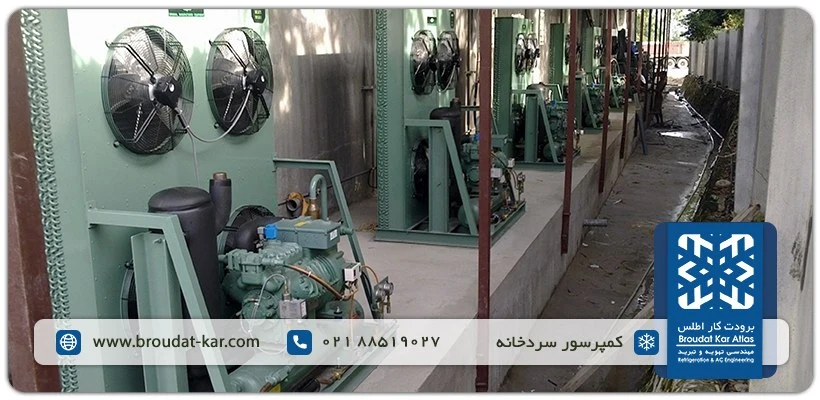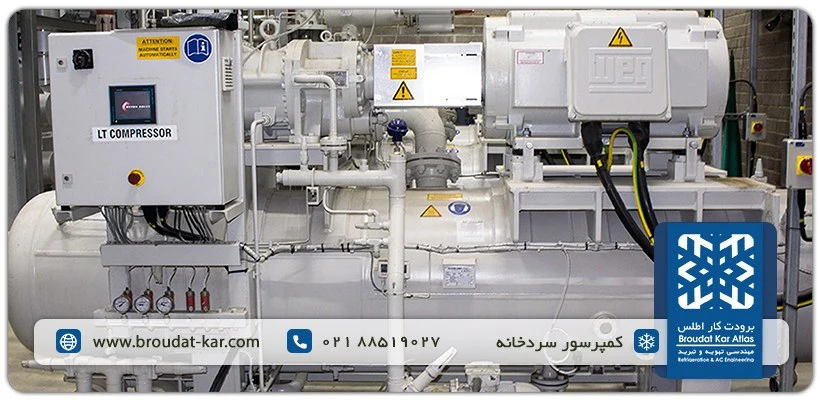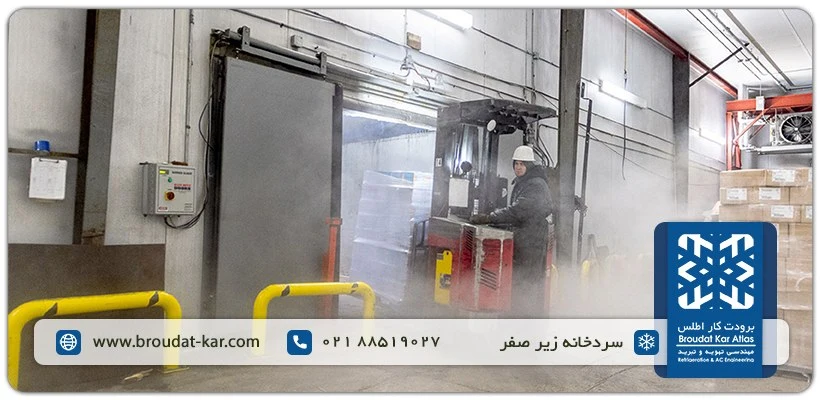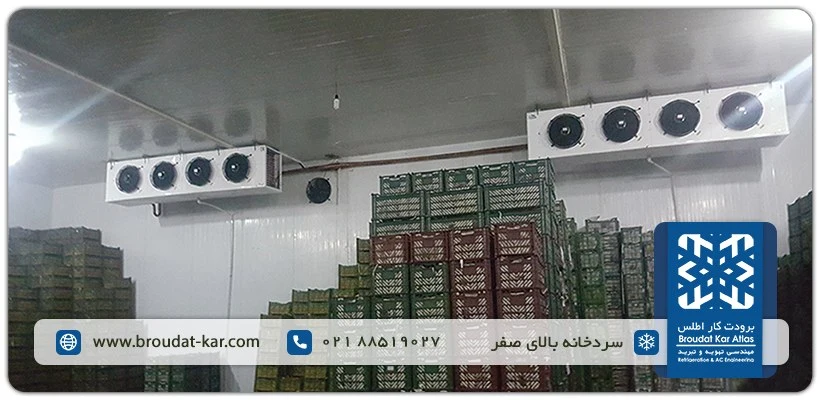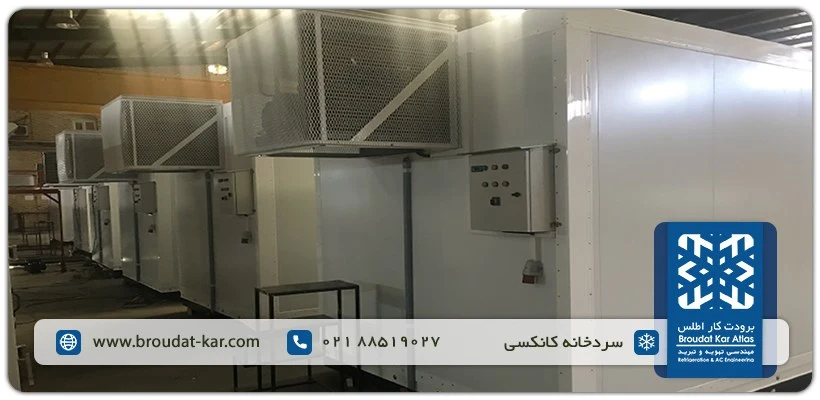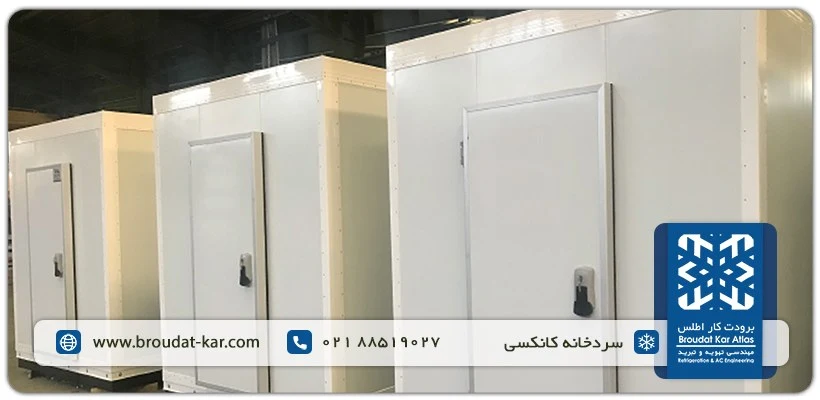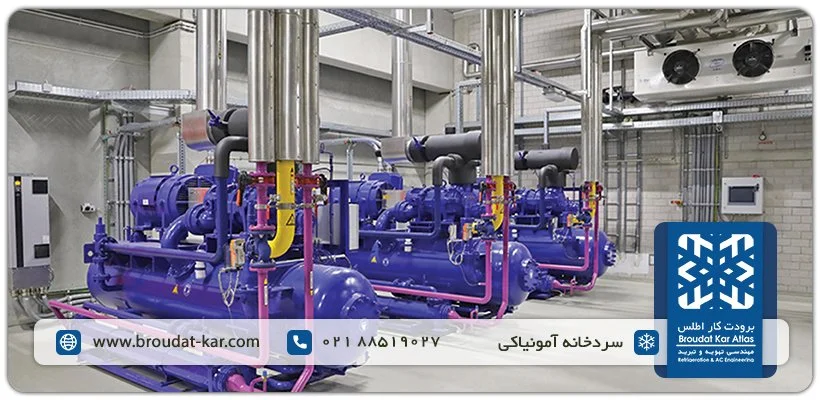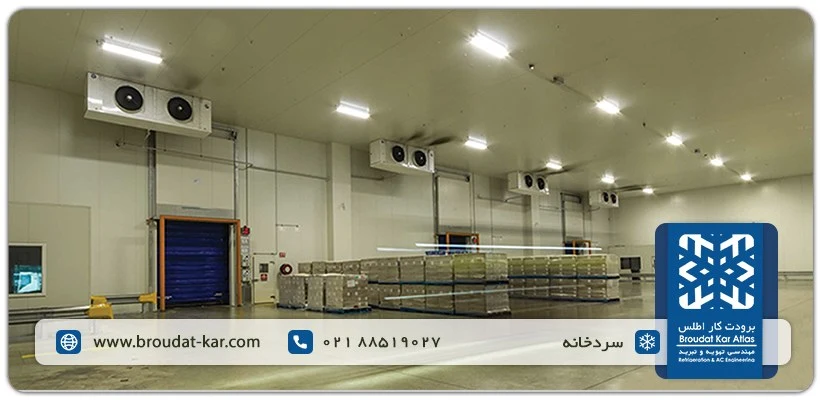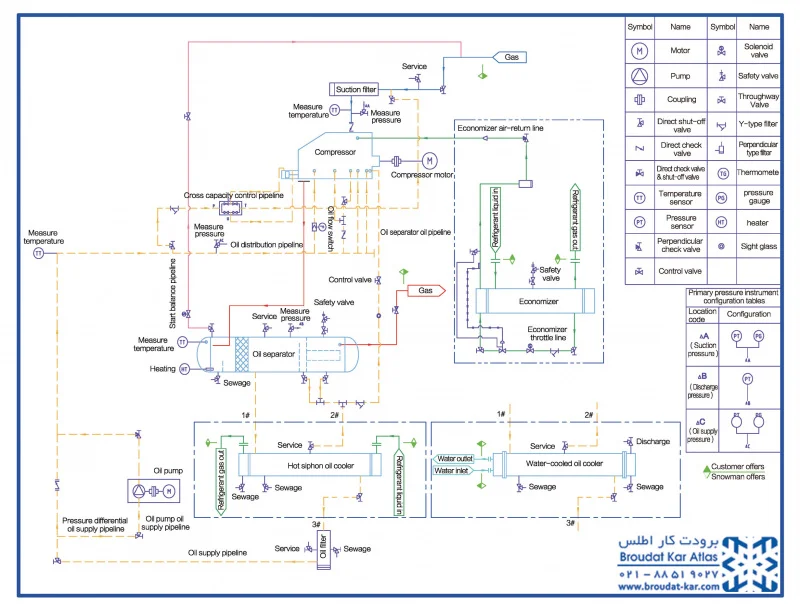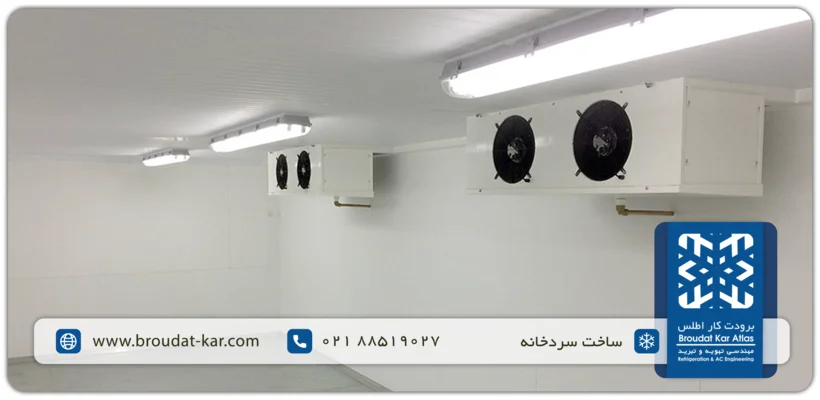Understanding Cold Rooms
A cold room, also known as cold storage, represents a specially insulated enclosure designed to regulate temperature, humidity, and atmosphere, tailored to the specific requirements of stored products.
Efficient cold room implementation stands as a pivotal element in ensuring the production and preservation of high-quality, safe products across various industries like food and pharmaceuticals. This necessity spans from burgeoning startups to established enterprises. These rooms offer a professional and hygienic solution, facilitating the storage of large quantities of sensitive orders and surplus resources.
Cold Room Specifications
The specifications of cold rooms vary according to specific requirements, necessitating advance determination. Those manufactured by Atlas Refrigeration Co., Ltd. typically encompass the following features:
- Wide Temperature Range: Ranging from an impressive -60 to +18 degrees Celsius.
- Tailored Dimensions: Customizable to seamlessly integrate with existing architectural layouts.
- Automated System Control: Fully automated operations minimize the need for constant operator intervention.
- Flexible Installation: Allows for easy assembly, disassembly, and relocation to alternative sites.
- Refrigerant Options: Offers the choice of common refrigerants like Freons, ammonia, and carbon dioxide.
- Additional Equipment: Provides the option to acquire supplementary control and monitoring tools, including temperature data loggers, mobile alert capabilities, and temperature control devices.
Cold storages manufactured by Atlas Refrigeration Company offer precise temperature control (±0.1 degrees Celsius) and optimal energy efficiency. Backed by a one-year warranty and 15 years of after-sales service, they are the ideal choice for preserving the freshness and quality of your products.
Optimal Cold Room Temperatures
Different products necessitate specific storage temperatures within a cold room. Consider the following guidelines:
- Processing and Packaging Hall: Maintained between +10 to +18 degrees Celsius.
- Fruit, Vegetables, and Dry Food Cold Room: Kept within the range of 0 to +7 degrees Celsius.
- Pharmaceutical, Cake, Confectionery, and Chemical Cold Room: Ideal temperatures range from 0 to +10 degrees Celsius.
- Ice Storage Cold Room: Maintained between -10 to 0 degrees Celsius.
- Meat, Poultry, Ice Cream, and Fish Cold Room: Best stored at temperatures ranging between -25 to -18 degrees Celsius.
- Freezing Tunnel: Designed for temperatures spanning from -40 to -30 degrees Celsius.
For more detailed insights into cold room temperature requirements tailored to various products, explore the articles available in the cold storage product maintenance temperature article in our website.
Utilizing Cold Rooms Across Diverse Industries
Cold rooms serve as pivotal assets in various sectors, catering to specific needs in:
- Livestock Farms and Slaughterhouses
- Dairy and Milk Product Facilities
- Poultry Farms and Chicken Slaughterhouses
- Fisheries and Aquaculture Industries
- Storage and Manufacturing of Pharmaceuticals
- Laboratory Settings
- Restaurants, Hotels, and Banquet Halls
- Chain Supermarkets
Their application extends to any industry requiring stringent control over temperature and humidity levels, offering a reliable and efficient solution for preservation and storage needs.
Cold Room Components
Cold Room Compressor:
The compressor, acting as the heart of the refrigeration cycle, offers diverse categories based on performance (reciprocating or scroll), refrigerant type (ammonia or freon), construction (hermetic, semi-hermetic, and open), and compression stages (single-stage or two-stage).
It’s selected and tailored to specific needs and budget considerations. Noteworthy brands include GEA, York, Mycom, Danfoss, Copeland, Bitzer, Refcomp, and Bock. Contact us for a compressor price list. Explore here for more insights into types of cold room compressors.
Cold Room Heat Exchangers:
The cold room evaporator and condenser serve as vital heat exchangers, individually calculated and designed for each unit based on factors like product type, cold room capacity, refrigerant, and defrost type. While industrial cold rooms often feature custom-designed condensers and evaporators, standard sizes cater to smaller and commercial units. Heat exchangers come in various types, such as air-cooled, shell and tube for water-cooled systems, and plate types.
Cold Room Insulation:
Insulation stands as a pivotal factor influencing cold room quality and energy consumption. Different insulation types include:
– Polyurethane Sandwich Panels: Featuring double-sided colored sheets with a density of 40 kilograms per cubic meter and thicknesses from 5 to 15 centimeters. These panels offer superior insulation, lower heat transfer coefficients, and ease of mobility.
– Insulation Sheets (EPS/XPS): Available with densities ranging from 20 to 40 kilograms per cubic meter and varying thicknesses.
– Doors: Crafted from injected polyurethane, these come in sliding and hinged types with customizable frames and fittings.
Choosing insulation involves considering the heat transfer coefficient; superior insulation translates to reduced equipment wear and lower electricity consumption, allowing for smaller cold room units.
Other Cold Room Equipment and Components
Beyond the mentioned components, a cold room incorporates various essential parts. Valves, refrigeration cycle controllers, and the electrical panel significantly contribute to efficiency and precise parameter control. Atlas Refrigeration Co. utilizes products from reputable brands like Danfoss, Castel, Parker, Hansen, Schneider, and Siemens. Contact us for equipment prices.
Categorizing Cold Rooms by Temperature Range
Below-Freezing Cold Room:
Primarily utilized for items like ice cream, butter, various meats, and frozen products, a below-freezing cold room maintains temperatures between -5 to -30 degrees Celsius. Adequate insulation, often 15 centimeters thick in polyurethane sandwich panels, is standard for this type of cold room.
Above-Freezing Cold Room:
Tailored for fruits, vegetables, medicines, cakes, and pastries, an above-freezing cold room adjusts its temperature based on stored products. For instance, medicines typically require temperatures within +4 to +8 degrees Celsius, while fresh apples thrive between -1 to +3 degrees Celsius. Insulation recommendations for above-freezing cold rooms lean towards a 10-centimeter thickness in polyurethane sandwich panels. Contact us for detailed information and prices regarding above-freezing cold room solutions.
Types of Cold Rooms by Function
Industrial Cold Room:
Designed for capacities exceeding 1,500 tons, an industrial cold room often partitions its total capacity into multiple chambers. This division offers several advantages, allowing for separate storage of diverse products within individual chambers. Additionally, during periods of lower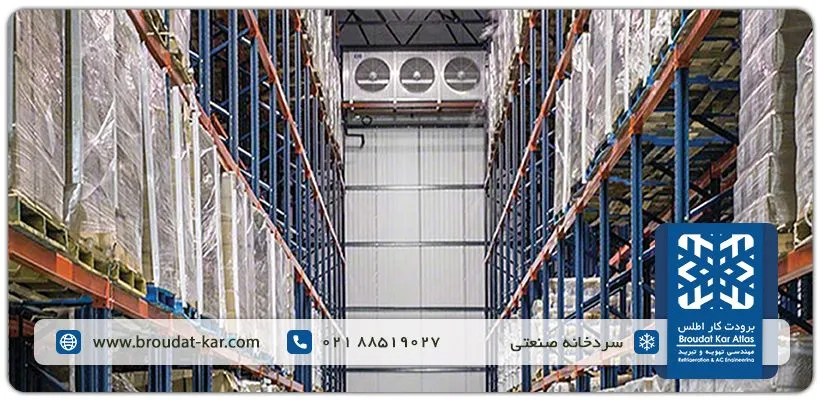
cold room utilization, smaller chambers can be activated, bypassing the need to control the temperature of larger tonnage areas. Industrial cold rooms typically employ ammonia-based refrigeration systems for optimal functionality. Explore industrial cold room prices for detailed insights.
Containerized Cold Room:
Characterized by mobility, containerized cold rooms suit individuals requiring a cold room in rented spaces or for temporary workshops outside urban areas. Constructed with iron structures and corner fittings, these rooms boast easy transportation facilitated by attached hooks.
However, adherence to specific dimensions is crucial during transportation to avoid categorization as traffic loads, which could pose challenges for cold room owners. The allowable dimensions are as follows:
– Maximum Length: 12 meters
– Maximum Width: 2.5 meters
– Maximum Height: 3 meters
For comprehensive information on containerized cold rooms, including pricing details, visit the “Containerized Cold Room Price” page.
Types of Cold Rooms Based on Refrigerant
Freon Cold Room:
Freon cold rooms utilize refrigerants from the freon family in their refrigeration cycles. Freons, divided into old (environmentally harmful) types like R-22 and R-11, and new (environmentally friendly) ones like R-134A and R-404A, offer versatility across compression cycles employing hermetic, semi-hermetic, and open compressor types. The non-reactivity of freons with copper, used in motor windings of hermetic and semi-hermetic compressors, makes them a viable choice. These colorless, odorless gases pose minimal toxicity and flammability risks. Suited for small and medium cold rooms, freon isn’t recommended for industrial setups. Freon cold rooms typically exhibit a Coefficient of Performance (COP) averaging between 6 to 7, contingent on the freon type utilized. Discover more about freon cold room pricing for detailed information.
Ammonia Cold Room:
Employing ammonia gas as a refrigerant, ammonia cold rooms champion an environmentally friendly approach. Industrial systems using ammonia necessitate central motor room type setups compatible with non-colored metals (excluding copper and brass) in contact with ammonia. Notably, fewer compressors suffice for larger capacities;
for instance, a 5,000-ton cold room might require two screw compressors with one serving as a backup. With a Coefficient of Performance (COP) averaging around 8, ammonia cold rooms boast reduced energy consumption compared to their freon counterparts. Delve deeper into ammonia cold room prices for comprehensive insights.
Types of Cold Storage Based on Product
In the design of cold storage facilities, the type of stored product determines the required temperature, humidity, and operating conditions. Each category of goods has its own specific preservation requirements. The following are the recommended storage conditions for different product types:
Red Meat Cold Storage:
Meat should first be frozen in a blast freezer down to approximately –35 °C before being transferred to storage. Long-term preservation is carried out at –18 °C to maintain color, texture, and nutritional value while preventing microbial growth.
Poultry and Fish Cold Storage:
Poultry and seafood products are frozen initially at –35 °C and then stored at –20 to –25 °C. A relative humidity of around 90 % is essential to prevent surface dehydration and freezer burn.
Ice Cream, Butter, and Whipping Cream Cold Storage:
These high-fat products require stable temperatures between –22 and –25 °C. Maintaining this range prevents ice-crystal formation and ensures smooth texture and product quality.
Fruit and Vegetable Cold Storage:
Fresh produce is typically stored between 0 and +5 °C with a relative humidity of 85 to 95 %. For example, apples and pears keep best near 0 °C, while leafy greens maintain freshness around +4 °C.
Dairy Cold Storage (Milk, Yogurt, Cheese):
Dairy products should be kept at +2 to +4 °C, with temperature fluctuations limited to less than ±1 °C to prevent souring or protein destabilization.
Pharmaceutical and Vaccine Cold Storage:
The recommended range is +2 to +8 °C with humidity below 65 % to ensure chemical stability. For vaccines, constant temperature monitoring and data logging are mandatory.
Chemical Cold Storage:
Depending on the chemical composition, storage temperatures may range from –5 to +15 °C. Organic and heat-sensitive compounds are often kept below zero to prevent unwanted reactions, oxidation, or evaporation.
Adhering to these precise temperature and humidity conditions in the design and operation of cold storage facilities ensures product integrity, energy efficiency, and extended service life of refrigeration equipment.
Dual-Temperature Cold Room
The term dual-temperature cold room refers to two different system configurations. In the small commercial type, a single condensing unit designed for sub-zero operation (around –18 °C) is installed, and the insulated chamber is divided by a partition wall into two zones — one operating below zero and the other above zero (typically +2 to +5 °C). The above-zero section does not have a separate refrigeration circuit; instead, its temperature is maintained by circulating cold air from the sub-zero compartment through a controlled fan-and-damper assembly, regulated by an independent thermostat. Proper design of the airflow path, fan capacity, and damper response is essential to ensure stable temperature and uniform air distribution in the higher-temperature zone.
In the industrial or multi-chamber type, each room can independently operate in either chilling (above zero) or freezing (below zero) mode. This flexibility is achieved through separate suction circuits, multi-mode electronic expansion valves, PLC-based control logic for mode switching, and customized defrost programs for each condition. During design, critical elements such as insulation thickness and door heaters for sub-zero operation, and compressor capacity control (inverter or hot-gas bypass) must be incorporated from the outset. Dual-temperature cold rooms provide an efficient and adaptable solution for facilities that need to store different products within two temperature ranges, without requiring two completely independent refrigeration systems.
Categorization of Cold Rooms by Volume
Understanding the varied sizes of cold rooms aids in their classification:
– Small Cold Room: Less than 50 cubic meters
– Commercial Cold Room: Ranges between 50 and 500 cubic meters
– Medium or Semi-Industrial Cold Room: Varying from 500 to 5,000 cubic meters
– Large or Industrial Cold Room: Exceeds 5,000 cubic meters
Calculating a cold room’s volume involves multiplying its length, width, and height. For instance, a cold room measuring 10 meters in length, 6 meters in width, and 4 meters in height totals a volume of 240 cubic meters, categorizing it as a commercial cold room within the specified range.
Calculating Cold Room Dimensions Based on Loading Capacity
Determining the required space for product storage involves careful consideration of product arrangement to facilitate easy access for equipment and ensure adequate cold air circulation.
Method 1: To accurately estimate dimensions, it’s recommended to gather information on packaging methods and product density before constructing the cold room.
Method 2: Approximate dimensions can be derived based on estimated product weight:
– For products stored below zero degrees (e.g., meat, poultry, fish), allocate 3 to 3.5 cubic meters per ton (1000 kilograms) of product.
– For products stored above zero degrees (e.g., fruits, vegetables), allocate 4 to 4.5 cubic meters per ton (1000 kilograms) of product.
Considerations for accessibility and air circulation space are integral aspects in this estimation method, ensuring optimal functionality within the cold room.
Calculating Cold Room Prices
Determining the price of a cold room involves a multifaceted process that hinges on several key factors, such as refrigerant type, compressor brand and type, insulation specifics, and door type. Here’s a step-by-step breakdown of the process:
- Customer Requirements and Data Collection:
– Gathering specifics like desired cold room temperature, product requirements, geographic location, capacity, and other relevant details.
- Estimation of Insulation Area and Cold Room Door Dimensions:
– Calculating the insulation’s square footage and determining the cold room door dimensions.
- Estimation of Compressor Power and Type, and Condenser:
– Assessing compressor power and type, along with selecting an appropriate condenser for the setup.
- Sizing and Design of Valves, Control Devices, and Electrical Panel:
– Designing valves, control devices, and the electrical panel to suit the requirements.
- Estimation of Installation and Operational Costs:
– Estimating expenses linked to installation and operational activities.
For small and medium cold rooms, Atlas Refrigeration Co. provides annual approximate price calculations available on the cold room price page. However, for complex projects like industrial or ammonia cold rooms, due to technical intricacies and equipment variations, providing an approximate price isn’t feasible. Each project necessitates an individual assessment for accurate price estimation. Contact us for information on industrial cold room prices tailored to your specific project requirements.
Atlas Refrigeration Co. Cold Room Services
Drawing from a stellar 30-year legacy within the national refrigeration industry, Atlas Refrigeration stands poised to offer tailored solutions aligning with your unique needs and budget for cold room design and construction. Leveraging extensive experience in executing a multitude of turnkey projects (EPC) for diverse government and private clients, the company extends a comprehensive suite of services encompassing design, construction, implementation, operational training, and post-sales support for cold rooms.
Cold Room Design Expertise
Atlas Refrigeration Co., supported by proficient specialists and its seasoned technical team, takes on the task of designing industrial and commercial cold rooms, tailoring each project to its unique conditions. The comprehensive cold room system design includes:
– Detailed Measurement Estimation: Providing comprehensive measurements for sandwich panel insulation and cold room doors.
– Refrigeration Load Calculations: Offering pertinent thermodynamic graphs for accurate load calculations.
– Refrigeration Compressor Power Estimation: Determining compressor power and presenting selection graphs for devices.
– Specification Determination for Heat Exchangers and Reservoir Tank: Defining physical and thermodynamic specs for vital components like evaporators, condensers, liquid separators, reservoirs, etc.
– Preparation of Foundation and Equipment Chassis Drawings: Creating essential structural diagrams.
– Floor Plans and Structural Elements: Developing plans for floors, roofs, and related structures within the cold room section.
– Mechanical Flow Diagrams: Crafting diagrams detailing refrigerant and oil routing for the system.
– Electrical and Automation Drawings: Providing comprehensive drawings for electrical and automation systems.
– Technical Consultation: Offering expertise for equipment procurement and execution, ensuring precision and quality throughout the process.
For inquiries regarding industrial cold room prices or further information, please don’t hesitate to contact us.
Investing in a well-thought-out design for your cold room lays the foundation for a top-notch, reliable system. With Atlas Refrigeration, you’re in capable hands for a full-spectrum design and engineering process, ensuring a high-quality, engineered cold room.
Our aim is to take the burden off your shoulders. From project inception to completion, we handle the intricate details of the design process. You won’t have to worry about navigating through contractor selections or price comparisons. Our team ensures a seamless experience, focusing on delivering the best equipment and ensuring ease of operation for your cold room.
Contact us today, and let’s embark on crafting a meticulously engineered cold room project tailored to your precise needs. Your satisfaction and a smoothly executed project are our priorities.
Cold room Construction
Our cold room construction follows an engineering-driven, systematic approach. We prioritize building high-quality cold rooms by employing cutting-edge machinery from globally recognized brands.
To construct a tailored, top-notch cold room for each project, it’s essential to start with a reasonably accurate estimation of goods’ weight and entry temperature. Understanding product storage conditions and standards is pivotal. Following the design and mechanical calculations for machinery and equipment capacity, the construction phase, including insulation and equipment installation, significantly influences durability and quality.
Implementing preventive measures and adhering to systematic operations extends the cold room’s lifespan and ensures optimal product quality.
Operation and Maintenance of the Cold Room
Effective operation, preventive maintenance, and regular servicing significantly extend the lifespan of cold room equipment while ensuring the stored products’ quality.
Atlas Refrigeration aims to achieve this by providing comprehensive training and essential checklists to operators and technical staff. For further insights, visit the maintenance guideline page.
Warranty and After-Sales Service for the Cold Room
Cold room owners prioritize reliable technical support due to the significant volume of stored products. At Atlas Refrigeration, we view sales as the start of a commitment, not the conclusion of a transaction. Upholding this principle, we are dedicated to promptly addressing potential issues with our constructed cold rooms.
To ensure customer convenience and satisfaction, our cold rooms are accompanied by a one-year warranty and an extensive 15-year after-sales service. This commitment underscores our dedication to providing ongoing support and assistance to our valued customers.
How to Order and Cold Room Delivery Time
To order a cold room and receive pricing details, please fill out our cold room price request form. Our experts will promptly respond to your inquiry.
Alternatively, you can reach out to us via the “Contact Us” page, providing the necessary information for price estimation and order placement. Upon receiving preliminary details, our experts will swiftly provide a price estimate and prepare a proforma invoice.
Once the proforma invoice is confirmed, our team will dispatch the equipment to the construction site. Our skilled technicians will then undertake the assembly and commissioning of the cold room.
The delivery time for the cold room ranges from 10 to 150 days, depending on the capacity. Rest assured, we strive to ensure a timely and efficient delivery process tailored to your specific needs.
Closing Statement
A cold room stands as a fundamental solution for numerous businesses. Crafting a top-tier, efficient cold room demands expertise and superior equipment. Atlas Refrigeration harnesses the prowess of its seasoned experts and cutting-edge technical knowledge to design, supply, and execute diverse commercial and industrial cold rooms—be it Freon or ammonia-based and varying in capacities.
Our track record of constructing cold rooms across the region for agricultural produce, aquaculture goods, protein items, dairy products, pharmaceuticals, ice storage, and beyond speaks volumes about our capability and commitment. Trust us to deliver quality solutions tailored to your needs, ensuring optimal storage for your varied products.
Call us for free consultation on refrigeration equipment
You can submit your coldroom proforma inquiry by filling out this form
The main difference between cold storage and industrial cold storage lies in their capacity and scale. Industrial cold storage facilities are designed to handle large volumes of products, whereas smaller cold storages accommodate products in smaller quantities with similar or closely aligned storage temperature requirements. Additionally, industrial cold storages often feature advanced controls for atmosphere and humidity, enhancing product quality preservation. They also tend to consume more electricity and require specialized maintenance for their equipment.
A cold room is generally used to maintain products at a specific temperature, ensuring their freshness over a period of time. In contrast, a blast freezer is designed to rapidly freeze products. For instance, meat intended for long-term storage should first be frozen in a blast freezer at around -40 degrees Celsius until the core temperature reaches at least -18 degrees Celsius. After this rapid freezing process, the meat can be transferred to a cold storage facility, where it is maintained at -18 degrees Celsius for extended preservation.
Related posts
Cold Room
Portable Cold Store; Design and Construction of Portable Cold Store + Price The portable cold room, also known as
What Is Meat Cold Storage? Meat cold storage, also known as a meat refrigeration facility, is a specialized center dedicated
What is dairy cold storage? Dairy cold storage stands as a pivotal element within the dairy industry, crucial for the
What Is Chicken Cold Storage? Chicken cold storage refers to specialized equipment designed for preserving poultry products like chicken
Fish and Shrimp Cold Storage Systems – Preserving Freshness Fish and shrimp cold storage facilities play an important role in
What is Fruit Cold Storage? A Fruit cold storage is a specialized facility designed to store fruits and vegetables
